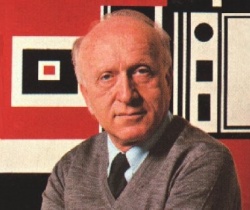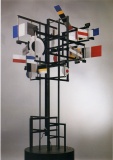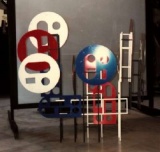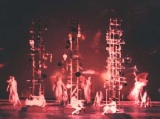Nicolas Schöffer
 | |
| Born |
September 6, 1912 Kalocsa, Hungary |
|---|---|
| Died |
January 8, 1992 (aged 79) Paris, France |
Nicolas Schöffer (Schöffer Miklós) was a Hungarian-born French artist, considered the founder of cybernetic art.
Contents
He was born in Kalocsa, Hungary and resided in Paris from 1936 till his death in his Montmartre atelier, Villa des Arts. His career touched on painting, kinetic sculpture, architecture, urbanism, film, TV, and music. Indeed he collaborated on music with Pierre Henry. All of the artistic actions of Schöffer were done in the pursuit of a dynamism in art.
This interest in artistic dynamism was originally initiated by the Cubo-Futurists and then intensified and solidified by the Constructivist artists, such as Naum Gabo, Anton Pevsner, Laszlo Moholy-Nagy and Ludwig Hirschfeld-Mack, who were concerned with opening up the static three-dimensional sculptural form to a fourth dimension of time and motion. And this was the intention of Schöffer as well. In 1948 he began exploring spatio-dynamics, later in 1957 the luminodynamics (by integrating light, music, film), and since 1959 the element of time resulting in the kinetic works (chronodynamics).
Schöffer however, coming well after, benefited from cybernetic theories (theories of feedback systems primarily based on the ideas of Norbert Wiener) in that they suggested to him artistic processes in terms of the organization of the system manifesting it (e.g., the circular causality of feedback-loops). For Schöffer, this enabled cybernetics to elucidate complex artistic relationships from within the work itself.
His CYSP 1 (1956) is considered the first cybernetic sculpture in art history in that it made use of electronic computations as developed by the Philips Company. The sculpture is set on a base mounted on four rollers, which contains the mechanism and the electronic brain. The plates are operated by small motors located under their axis. Photo-electric cells and a microphone built into the sculpture catch all the variations in the fields of color, light intensity and sound intensity. All these changes occasion reactions on the part of the sculpture.
Consequently his kinetic sculptural compositions were able to parallel the work of Warren McCulloch and his adaptation of cybernetics in formulating a creative epistemology concerned with the self-communication within an observer's psyche and between the psyche and the surrounding environment. This is the primary usefulness of cybernetics in studying the supposed subject/object polarity in terms of artistic experience.
Works
CYSP 1 (1956). Aluminium and mixed media (computer, traction motor, direction motor, 2 microphones, 2 photoelectric cells, 19 micromotors), height 2,6 meters. The first spatiodynamic sculpture, having total autonomy of movement (travel in all directions at two speeds as well as axial and eccentric rotation (setting in motion of its 16 pivoting polychromed plates).
KYLDEX 1 (1973). Cybernetic Luminodynamic Experiment 1, Hamburg Opera. 5 autonomous cybernetic sculptures dance with the ballet of the Hamburg Opera and the two stars, Carolyn Carlson and Emery Hermans, while lighting effects combine with the ups and downs of various screens and projections while the music of Pierre Henry plays.
Publications
- Le Spatiodynamisme, AA, Boulogne sur Seine, 1955.
- La Ville Cybernétique, Tchou, Paris, 1969; Denoël-Gonthier, Paris, 1972. [1]
- Le nouvel esprit artistique, Denoël-Gonthier, Paris, 1970.
- La Tour Lumière Cybernétique, Denoël-Gonthier, Paris, 1973.
- Album Art et Société album, sérigraphies et relief métal, entretien avec Jean-Louis Ferrier, Denoël, Paris, 1976.
- La nouvelle charte de la ville, Denoël-Gonthier, Paris, 1974.
- Sur l'aménagement du temps - Essai de Chronogénie, en participation avec Joël de Rosnay, Michel Serres, J.P. Dupuy, René Zazzo, Edgar Ascher, Jean Cloutier, E.J. Koelin. Denoël-Gonthier, Paris, 1974.
- Perturbation et Chronocratie, Denoël-Gonthier, Paris, 1978.
- La Théorie des Miroirs, Pierre Belfond, Paris, 1981.
- Discours de réception à l'Académie des Beaux-Arts, Institut de France, Paris, 1982.
- Surface et Espace, Capitales, Paris, 1990.
Literature
- Philippe Sers, Entretiens avec Nicolas Schöffer, Paris: Pierre Belfond, 1971.
- Julia M. Busch, A Decade of Sculpture: the New Media in the 1960s, Philadelphia: The Art Alliance Press, and London: Associated University Presses, 1974.
- Frank Popper, From Technological to Virtual Art, MIT Press, 2007.
Links
- Nicolas Schöffer's website at OLATS put together by the Schöffer family
- Nicolas Schöffer at compArt daDA
- Extensive documentation of CYSP 1
- Nicolas Schöffer's Précurseur de l’art cybernétique exhibition, 2005
- Images of his studio
- Review of his 2005 exhibition by Joseph Nechvatal
- Sound recordings from Schöffer's spatiodynamic scultpures
- Nicolas Schöffer at French Wikipedia
- Nicolas Schöffer at English Wikipedia








